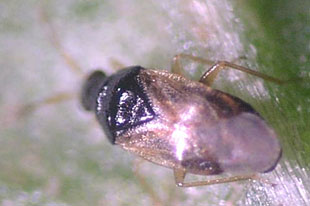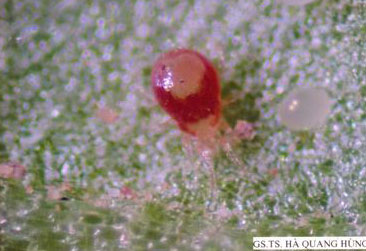Use 'natural enemies' to replace pesticides

Stink bugs catch adults
The scientists of Insects, Department of Agricultural Sciences at Hanoi University of Agriculture 1 have successfully implemented the process of breeding prey spiders with the power to attack white spiders and vermilion spiders, and strong prey to catch prey. Attack thrips.
This is considered a measure to use 'natural enemies' to control pests of plants, begin to experiment and bring high efficiency in productivity and quality of agricultural products in the suburbs of Hanoi, and open applications. wide on the land area of the provinces in the country.
Currently in Vietnam, harmful insects and spiders such as vermilion spiders and thrips cause significant damage to cucumber, gourd, squash, beans, oranges, lemons, cotton, peppers, coffee, roses and many. Other crops. To prevent this group of pests and spiders, farmers often spray up to ten times the chemical drugs in one crop, but the effect is not high, causing environmental pollution as well as affecting their own health and those people around.
From the initial success
Considering the actual effectiveness of this method of using insects to kill insects, Vietnamese scientists must admit that this is a measure of 'natural enemies' to protect plants widely applied in many countries. The world, including China and the Netherlands, has given these countries great progress in agricultural production.
Many biological companies such as the Dutch company Koppert have produced a series of prey spiders, parasitic bees . providing farmers with cucumber, sweet peppers, tomatoes, strawberries and fields to grow. beans, cotton, roses . bring high efficiency in the prevention of red spiders, mealy bugs and chalk. The products of vegetables, fruits and flowers are very safe that Dutch farmers do not have to use any chemical drugs, once a dream of Vietnamese scientists.

Spiders catch adult prey
Associate Professor, Dr. Nguyen Thi Kim Oanh, who used to work and study in 'the country of tuylip flower', said the specialized biological company raising prey spiders sold to farmers. Depending on the area and the number of spiders and the density of harmful spiders, the amount of spider catch corresponding to the number of harmful spiders is controlled.
Taking advantage of natural conditions in cultivation in our country, for the past two years, scientists from Hanoi Agricultural University 1 have implemented the breeding of spiders and stink bugs. Through investigation shows that the spider catches Amblyseius sp. appeared very popular on plants affected by small spiders in Vietnam, resulting in lab and in-farm multiplication results showed that this species has a high rate of natural growth, has the power to eat large spider spiders and complete All have the ability to control the number of harmful red spiders in the wild. In particular, the breeding of prey spiders is very convenient for the northern climate, from February to November every year.
The breeding room for spiders is temporarily in the experimental area of the Insect Department. The process of capturing spider prey is carried out by associate professor, doctor Nguyen Van Dinh, Dean of Agronomy and research team. In particular, it was necessary to cultivate beans in a clean environment before. The most suitable food to breed prey spiders is the vermilion spider. When the beans reach six leaves, drop the red spider spider into the rate of 10 adults / tree. When the number of red spiders is large, about 500 new plants / plants release prey spiders, each of 2-3 plants.

Experiment with stink bugs catching prey in the thrips room of cucumber
Only after seven to eight weeks did the number of prey spiders increase by 13 times compared to the initial stocking density, then bring the spider to catch prey and its food to areas where vegetables and colors need to be protected. . In order for spiders to catch prey to grow and develop quickly in an environment with little red spider, scientists used both white spiders and some other foods such as pollen and honey to replace them, helping spiders catch prey. life maintenance during storage and transportation.
Catching bugs have many species being studied by some countries in the world, being natural enemies of many harmful insects. In Vietnam, the team of scientists also cultivated stink bugs to catch Orius Sauteri bait to kill small-sized thrips on eggplant, gourd, zucchini, beans, cucumbers, potatoes . The adult bugs catch adult prey about 1.73-1.9 mm long. Success in capturing stink bug bugs is just one of many contributions of not only Professor, Doctor, and Teacher of Excellence Ha Quang Hung for nearly 40 years of teaching and research but also of many teachers. Insects. Mr. Hung is considered a famous entomologist not only by his position as Secretary General of the Vietnam Association of Insects, Member of the Executive Committee of Vietnam Plant Protection Association, but also because he is the author of many works. The scientific process has practical value.

Dropping prey spiders into bean fields
For the first time, farmers growing cucumbers in Van Duc commune, Gia Lam, Hanoi put prey on the bugs to control the number of thrips, making the number of thrips not to exceed the threshold. While before, the farmer's field of cucumber must spray at least eight times, sometimes up to 13 times in a crop to prevent thrips. Green zucchini, 'waist' cucumbers, and curls are attacked by thrips. The yield of cucumbers reached 208kg / rod if stink bugs were released, equal to spraying pesticides. The cost of using prey to catch prey is equivalent to buying pesticides, but growers are more secure with using bugs because of their health and ecological environment.
In the cucumber field of Mr. Nguyen Van Hung at Dang Xa Cooperative, also in Gia Lam district, he used to spray chemicals regularly for about VND 130,000 per acre. Mr. Hung said that when putting bugs caught to control thrips in the field, the fruit yield is no less than the previous crop, but it is recognized as a clean vegetable so the price is higher.
Towards clean agricultural products
Over the past two years, a team of scientists has been cultivating 'natural enemies' in natural conditions, without the support of many devices. The desire of scientists is to not only stop at a scientific topic that has been highly appreciated by the Ministry of Science and Technology but also to develop the effects it brings in the Vietnamese field.
Compared to pesticide spraying, the use of 'natural enemies' seems new and strange to farmers in our country. There are a number of companies that agree to accept the 'agent' of this special product. Meanwhile, the number of spiders and stink bugs that are preyed by the farmers does not meet the current demand for crop protection. Hanoi University of Agriculture 1 is planning to invest in expanding the breeding room with modern equipment to continue researching and completing the breeding process and establishing a synchronous 'production line' and continuous. According to Professor, Dr. Ha Quang Hung, if the infrastructure for farming is guaranteed, then every 19-20
 The squashy green pumpkin that has been attacked by thrips can 'release' a wave of prey on spiders or stink bugs.
The squashy green pumpkin that has been attacked by thrips can 'release' a wave of prey on spiders or stink bugs.
Professor Hung has a habit of going on business trips, and he always spends time "visiting" the fields in combination with "giving lectures" to practitioners. In the 'classes', for him and the scientists, introducing new methods, using 'natural enemies' to protect crops for farmers seems to have become their responsibility. Of course, before implementation applies to every farmer, scientists must go to survey, investigate thoroughly in the field, assess the ability of dispersal, evolution of harmful insects, then evaluate , forecast pest risk. Integrated pest management (IPM) helps farmers with specific measures of pest management or integrated control.
In the future, the development of breeding spiders and stink bugs will help to make the product cost suitable for the farmers' pocket and lower than the cost of buying pesticides. Talking about encouraging farmers to use this measure, Associate Professor, Dr. Kim Oanh emphasized: 'When buying' natural enemies' to control pests, farmers must be committed to 'insurance' by their suppliers. for their crop products. At the same time there is a plan for technical guidance for them to use effectively in the field '.
The prey spiders have a high survival ability when stored in plastic containers with a volume of 10ml, along with fillers are corn cob and food, very convenient for the process of bringing them to the field. However, scientists are also looking for optimal methods to preserve, transport 'natural enemies' to the fields, to the hands of farmers. Notably, the use of spiders, stink bugs to prevent spiders and thrips is very suitable for plants in greenhouses, greenhouses because there are few natural enemies and space in that environment. limit.
It is known that if the 'chain' of breeding spiders and stink bugs is complete, scientists will cooperate with local Plant Protection Sub-departments to apply safe vegetable growing areas. A fresh vegetable development company in Hanoi, led by Dutchman Siber, will also be a customer who regularly buys products to supply clean vegetable fields in Tang My and Nam Hong villages in the district. Dong Anh. The production of fresh vegetables is here after harvesting, the company exports to many countries in the region and the world.
From the success of the process of breeding spiders to catch prey and stinking bugs, scientists from Hanoi Agricultural University 1 will conduct research on breeding other insects and prey spiders such as ancient bugs. geese catch prey (eat larvae of flakes that cause much damage on vegetables) .
Many innovative techniques have been applied such as IPM, sheltered houses gradually meet the increasing demands on consumers' safe vegetables. Before the strong development of world science and technology, the use of chemical drugs in the prevention of insects, harmful spiders should be limited to the lowest level and biological measures must be considered invest in improving production efficiency and quality of agricultural products, contributing to building a clean and stable agriculture.
Tra My
- Pesticides are harming rice
- Turn cigarettes into pesticides
- Breeding natural enemies to protect crops
- How to 'reduce' pesticides in vegetables
- Detection: Good pesticides for mulberry trees but for silkworms
- Video: History of invention and use of pesticides
- The risk of children with autism is caused by their mother's exposure to pesticides during pregnancy
- Pesticides from plants
- Pesticides reduce the IQ of children
- Pesticides affect 3 generations
- 'Vaccinate' plants to fight pests and diseases
- How to execute the feared enemies of the Mayans
 'Barefoot engineer' invents a pipeless pump
'Barefoot engineer' invents a pipeless pump Process of handling dead pigs due to disease
Process of handling dead pigs due to disease Radiometer
Radiometer Warp Engine: Technology brings us closer to the speed of light
Warp Engine: Technology brings us closer to the speed of light Spiders can lure male fireflies into their nets with their 'love calls'
Spiders can lure male fireflies into their nets with their 'love calls'  Unique techniques help animals 'survive' through winter
Unique techniques help animals 'survive' through winter  NASA finds out the truth about 'Mars spiders' in 'Inca city'
NASA finds out the truth about 'Mars spiders' in 'Inca city'  The strange way of 'taking care of children' of giant sea spiders
The strange way of 'taking care of children' of giant sea spiders  New research reveals the mystery of jumping spiders' dreams
New research reveals the mystery of jumping spiders' dreams  Scientists turn spider corpses into 'zombie robots'
Scientists turn spider corpses into 'zombie robots' 